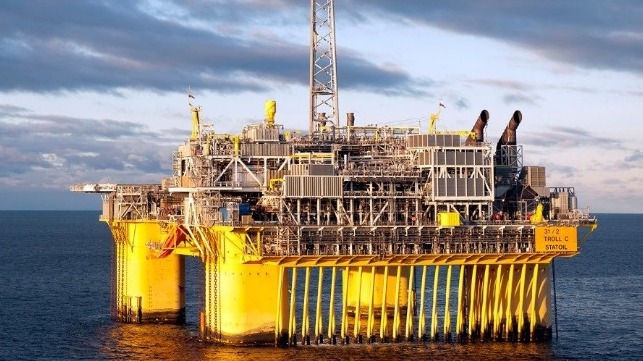 The Troll C platform in the North Sea. (Photo: Øyvind Hagen)
The Troll C platform in the North Sea. (Photo: Øyvind Hagen)
_x000D_
By MarEx 2018-06-11 20:18:00
_x000D_
_x000D_
Norwegian energy company Equinor is looking to supply power from land to three offshore platforms that are currently powered by gas turbines. This could cut CO2 emissions from the Norwegian Continental Shelf by more than 600,000 tons per year. NOx emission reductions of around 2,500 tons would also be achieved.
_x000D_
_x000D_
On Troll C, the CO2 emission reduction potential is 365,000 tons per year by platform electrification. Electrification of the Sleipner field center and Gudrun, which is powered from Sleipner, has the potential for reducing emissions by 250,000 tons per year.
_x000D_
_x000D_
Adding this to reductions that will be achieved by choosing land-based power supply to Johan Sverdrup, Gina Krog and Martin Linge, Equinor says there is potential for cutting more than 1.3 million tons of CO2 in total per year. This is equivalent to annual emissions from more than 650,000 private cars, or approximately every fourth private car on Norwegian roads.
_x000D_
_x000D_
“Powering major offshore oil and gas installations from land is no easy task,” says Arne Sigve Nylund, Equinor’s executive vice president for the Norwegian Continental Shelf. “There are many challenges, both technical and financial, and several of our installations are in areas with no possibility for tying in to land-based power supply. The reason why we are looking at the potential for land-based power to Troll C and the Sleipner area is that they can utilize existing power supply infrastructure, they have large remaining resources and the measures will lead to considerable CO2 reductions.”
_x000D_
_x000D_
All three platforms are in field areas that are already receiving power from land. On the Troll field the Troll A gas platform has been powered from land since it came on stream in 1996 and is operated with minimal production emissions. The aim going forward is to find a solution for tying Troll C to the same power solution by a power cable from the Kollsnes plant by Bergen.
_x000D_
_x000D_
The Johan Sverdrup field will be powered from land, together with several fields on the Utsira High, including Equinor’s Gina Krog field, which came on stream last year. Possibilities for extending the power supply from Gina Krog are being pursued, with the aim of connecting the Sleipner field center and the Gudrun platform to the land-based power supply.
_x000D_
_x000D_
Last year Equinor reached its goal of reducing annual CO2 emissions from the NCS by 1.2 million tons from 2008 to 2020, almost three years ahead of schedule. Consequently, the company raised its ambition and aims to reduce CO2 emissions from its offshore operations by a further two million tons per year by 2030.
_x000D_
source: www.maritime-executive.com


